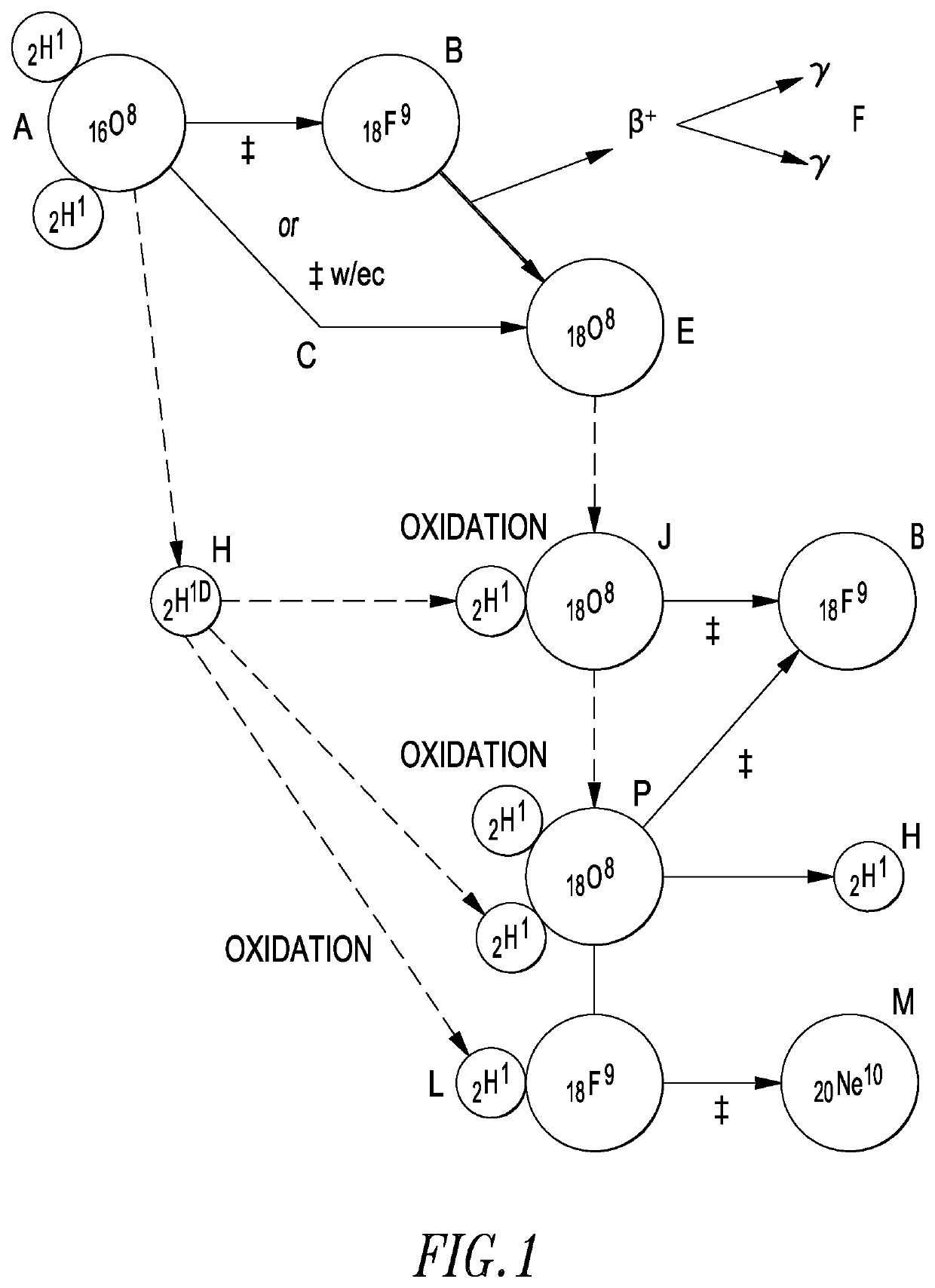Metal oxygen fusion reactor
a fusion reactor and metal oxygen technology, applied in nuclear reactors, greenhouse gas reduction, nuclear engineering, etc., can solve the problems of limited resources for fission nuclei, highly radioactive species that can have half-lives of thousands of years, etc., to reduce the relative rate of change (rroc) and reduce the coulomb barrier to generate fusion
- Summary
- Abstract
- Description
- Claims
- Application Information
AI Technical Summary
Benefits of technology
Problems solved by technology
Method used
Image
Examples
example 1
[0044]FIG. 1 is described as follows: Steps A-B: fusion of Deuterium with adjacent Oxygen atom, generating a Fluorine-18 isotope.
[0045]Steps B-C: Fluorine-18 generates Oxygen-18 through Electron Capture.
[0046]Steps B-E: Fluorine decay generating Oxygen-18, and F, emitting a pair of gamma photons through positron-electron annihilation.
[0047]Steps A-H: Fusion of Deuterium with adjacent Oxygen atom liberates an excess Deuterium atom.
[0048]Steps E-J / H-J: Free Deuterium (Heavy Hydrogen) combusts with free Oxygen, forming an Hydroxyl molecule (OH) ignited by the electric spark.
[0049]Steps H-L / B-L: Free Deuterium (Heavy Hydrogen) combusts with free Fluorine, forming an FH molecule ignited by the electric spark.
[0050]Steps H-P / J-P: Hydroxyl (OH) molecules may further combust with free Deuterium or Hydrogen to form H2O (D2O), ignited by electric spark.
[0051]Steps L-M: Fusion of Deuterium / Fluorine or Oxygen to form Neon.
[0052]For example, and referencing FIG. 1, signature characteristics of D...
example 2
[0064]FIG. 2 shows a reaction vessel [1], a first electrode [2], a second electrode [3], a vent [4], an atmosphere [5] comprising deuterium and argon, a spark gap [6] capable of producing 5,000 volts, and a deuterium reservoir [7].
example 3
[0065]A process that manipulates the conjectured Relative-Rate-of-Change effect to either accelerate or retard apparent time, and indirectly, radioactive decay rates. FIGS. 3 and 4: The method can accelerate and decelerate the radioactive decay of unstable uranium metal (U-235) by fission or radioactive decay. Existing applications of uranium metal, that is, U-238, include X-ray shielding, munitions, and ballast.
[0066]In FIG. 4, a direct application of induced Relative-Rate-of-Change (RRoC) uses capacitive plates to deplete electrons from a plate of depleted uranium, which contains less than 2% of U-235. This level of unstable (radioactive) U-235 isotope is toxic for bio-organisms. Accelerating the decay of U-235 will increase the value of safety of the remaining, more stable U-238, which is still radioactive but with a half-life of 4.4 billion years.
[0067]As shown in FIGS. 3 and 4, a capacitor comprises a positive plate 31 and a negative plate 32 separated by a dielectric layer 33....
PUM
 Login to View More
Login to View More Abstract
Description
Claims
Application Information
 Login to View More
Login to View More - R&D
- Intellectual Property
- Life Sciences
- Materials
- Tech Scout
- Unparalleled Data Quality
- Higher Quality Content
- 60% Fewer Hallucinations
Browse by: Latest US Patents, China's latest patents, Technical Efficacy Thesaurus, Application Domain, Technology Topic, Popular Technical Reports.
© 2025 PatSnap. All rights reserved.Legal|Privacy policy|Modern Slavery Act Transparency Statement|Sitemap|About US| Contact US: help@patsnap.com



